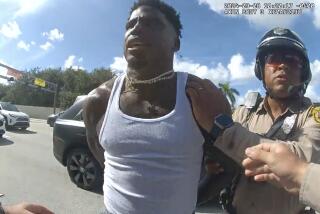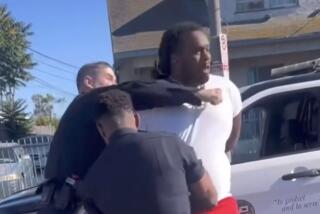AFTER THE RIOTS: THE SEARCH FOR ANSWERS : Before Rodney King, South L.A. Had Its Own Symbol of Injustice : Beating: Howard Hamm, 63, is suing over injuries he suffered during a 1990 arrest. His age and professional status made the case shocking to the community.
- Share via
When people speak of police brutality in areas such as the Crenshaw district and South Los Angeles, they are as likely to mention Howard Hamm as Rodney G. King.
Six months before the King beating, Los Angeles police stopped Hamm, 63, on suspicion of drunk driving. He ended up in the hospital with baton welts on his head and back. Twenty months later, the scars are still visible from at least eight blows to the head, back, leg, shoulders and arm.
While King’s beating graphically portrayed the use of force by police to the outside world, Hamm, a polite and soft-spoken widowed grandfather, stood out as a disturbing local example of injustice in communities that were perhaps most enraged over the verdict.
On the third floor of the May Co. in the Baldwin Hills Crenshaw Shopping Plaza, where he sells furniture, Hamm is often engaged in conversations about his beating, more so now because of the King case verdicts and the violence that erupted in the area.
“Rodney King is just a catalyst for a lot of what has already happened,” said Julia Harris, whose fried chicken restaurant at Vernon and Vermont avenues was gutted during the riots. “Look at what happened to the man at the May Co. We have never gotten justice around here.”
James Watt, who has lived in Los Angeles since 1943 and runs a Filipino-Chinese restaurant in the Crenshaw district, says Hamm’s beating has angered many in the area, particularly because of his age and professional status.
“This is a gentle guy who goes about his day-to-day tasks,” Watt said. “As old as he is and as small as he is (5-foot-9), who could he threaten? Who could he fight? If you are black around here, no matter who you are, brutality from the police seems to have become a way of life.”
Hamm has trouble recalling the night of Sept. 27, 1990, without pausing in mid-sentence to weep, then catch his breath, apologize and continue. He carries in his wallet the wilted photographs that show the purple-black bruises and the bloodied gauze.
“People say: ‘It couldn’t happen to you, Howard. You couldn’t hurt a fly,’ ” he said. “And I tell them: ‘Yes, it can happen. Look at this. You better be careful out there.’ ”
It had been a particularly stressful day at work that Thursday in September. Hamm was new on the May Co. job, his second career after he worked at Hughes Aircraft for 9 1/2 years.
After work, he stopped at a bar on 54th and Arlington and watched the guys shoot pool. He drank two glasses of wine and left after 20 minutes, Hamm said.
What happened next is in dispute, and at the heart of Hamm’s $5-million lawsuit against the city, Chief Daryl F. Gates and Officers Richard Blue and Bernadette Leiker. No trial date has been set.
Police say Hamm was in his car speaking with a prostitute when they spotted him. Hamm says there was no prostitute. Police say Hamm made an illegal U-turn and did not stop before making a right turn on a red light. The arrest report says Hamm was stopped because of the prostitute. A separate report says police believed Hamm had been driving drunk.
Hamm’s blood-alcohol reading was 0.20%, more than twice the state’s legal limit, according to the public defender’s office. Hamm insists that he was not drunk and that he rarely drinks. Although he was charged with three counts--driving under the influence, excessive blood-alcohol level and resisting arrest--he pleaded no contest to public intoxication, a misdemeanor, and paid a $242 fine.
Leiker and Blue say a combative Hamm resisted arrest and tried to break free once his left wrist was handcuffed. After the officers knocked his feet from under him, Hamm grabbed Leiker’s leg. She hit him twice on the back and shoulder with her baton. The third time she swung, Hamm “moved his head into the path of the baton blow and was hit in the head,” the officers said.
Blue then hit Hamm twice in the back, forcing him to release Leiker’s leg. Hamm stood up. Blue said he grabbed Hamm’s left arm and struck him once in the left leg. Hamm took a fighting stance and Blue hit him twice more in the arm. The officers said he started to run, lost his balance and fell backward, hitting his head on the pavement. On the ground, Hamm was handcuffed.
Supervisors at the 77th Street Division ruled the use of force necessary because Hamm “went from passive resistance to active resistance to physically assaulting the officer.” An internal affairs investigation has exonerated the officers of any wrongdoing.
Leiker had been accused of using excessive force four times between 1987 and 1989, said Hamm’s attorney, Scott Craig. Blue had been accused in three instances, all of which occurred within a two-month period in 1989.
Deputy City Atty. Marsha Berkowitz, who is representing the city, Gates and the officers, declined comment.
Hamm, who weighs 180 pounds, said “it takes all the energy I have to swat a fly.” He remembers being pulled over and asking Blue why he had been stopped. Blue asked for Hamm’s driver’s license, went to his car, came back, ordered him out and tried to open the locked door.
Hamm said he asked again why he had been stopped and Blue said: “N-----, get out of the car.” Hamm saw the baton and slowly got out as Blue swung the stick. “N-----, when I tell you to get out of your car, I mean get out,” Hamm recalled the officer saying.
As he stepped out of the car, Hamm said, he moved backward to avoid the blows and heard Leiker yell, “He’s getting away!” The officer pushed him from behind and Hamm fell, Hamm said.
Blue pinned Hamm’s face to the ground with his foot and struck him with the baton, Hamm said. Hamm covered his bleeding face with his hands.
“If death had come upon me, I was ready to go,” he said. “I figured this was it.”
Hamm said that while he was on the ground, Blue began beating him again. Blue then grabbed him, pulled him to his feet and rode with him in an ambulance to the hospital.
Nearly two years later, Hamm says his arm, back and leg still ache and three fingers of one hand are numb. Headaches are constant.
Preparing to sleep fills him with dread because of the constant nightmares.
“I wake up, screaming ‘No! No! No! I didn’t do anything!’ ” Hamm said. “The nightmares come into my mind and there’s nothing I can do about them. It’s like a tornado.”
When the rioting came, Hamm stayed indoors at home, watching the devastation on television. Despite his experience with Los Angeles police, he could not understand the destruction.
“Violence is no solution,” he said, thinking about his own experiences. “You obey the laws of the land and the word of God. If the laws of the land and the courts can’t change things, no one person can.”
More to Read
Sign up for Essential California
The most important California stories and recommendations in your inbox every morning.
You may occasionally receive promotional content from the Los Angeles Times.




![Vista, California-Apri 2, 2025-Hours after undergoing dental surgery a 9-year-old girl was found unresponsive in her home, officials are investigating what caused her death. On March 18, Silvanna Moreno was placed under anesthesia for a dental surgery at Dreamtime Dentistry, a dental facility that "strive[s] to be the premier office for sedation dentistry in Vitsa, CA. (Google Maps)](https://ca-times.brightspotcdn.com/dims4/default/07a58b2/2147483647/strip/true/crop/2016x1344+29+0/resize/840x560!/quality/75/?url=https%3A%2F%2Fcalifornia-times-brightspot.s3.amazonaws.com%2F78%2Ffd%2F9bbf9b62489fa209f9c67df2e472%2Fla-me-dreamtime-dentist-01.jpg)








